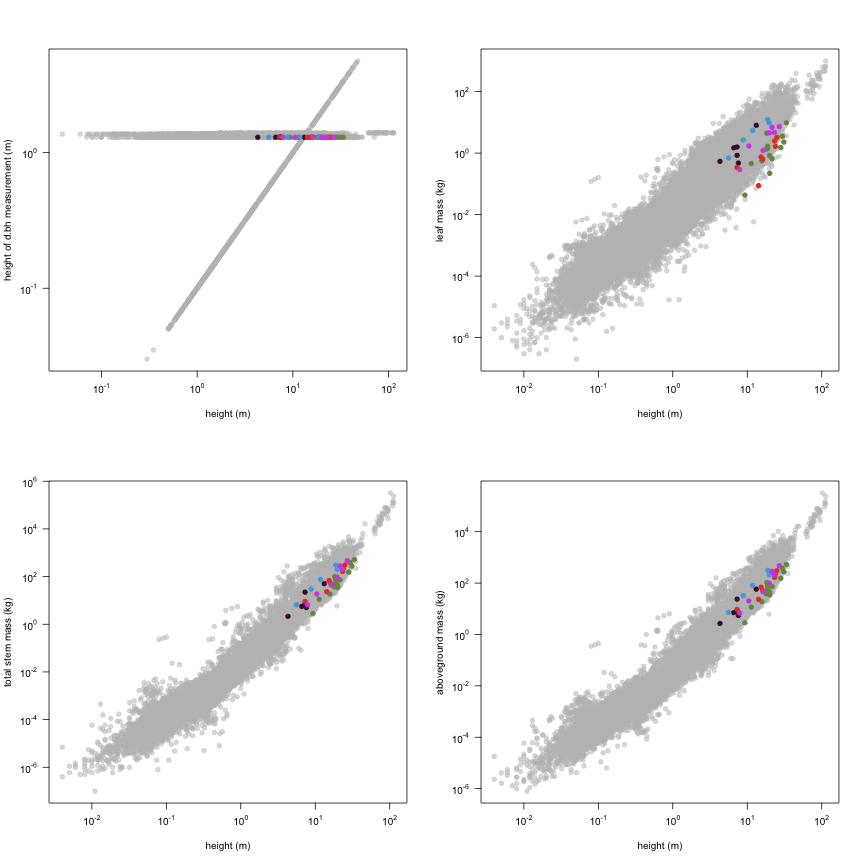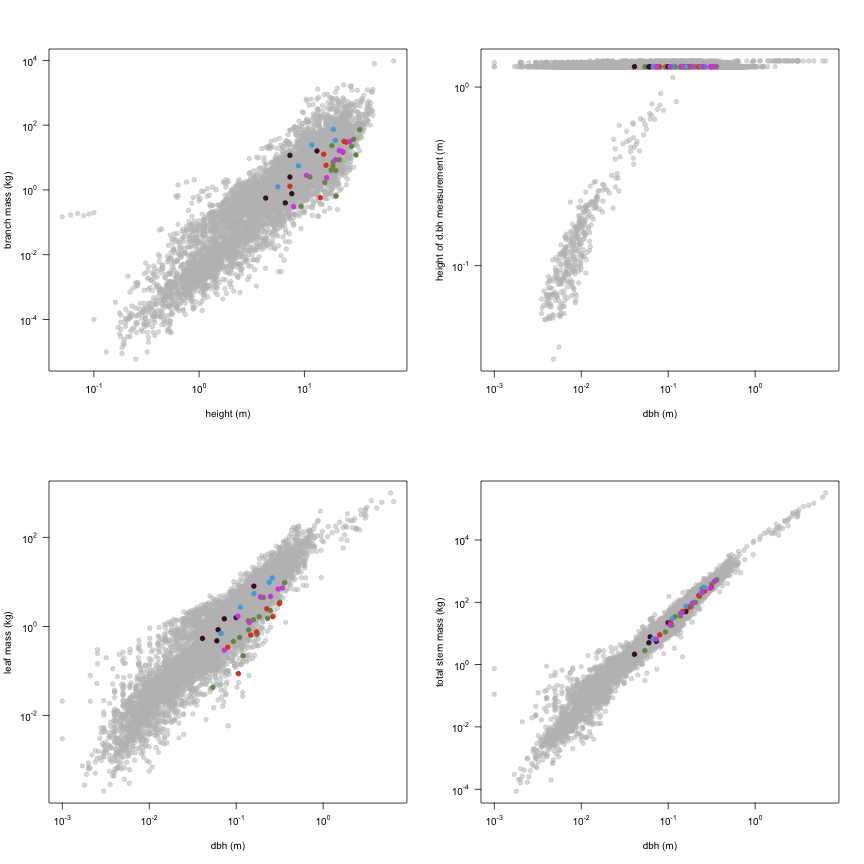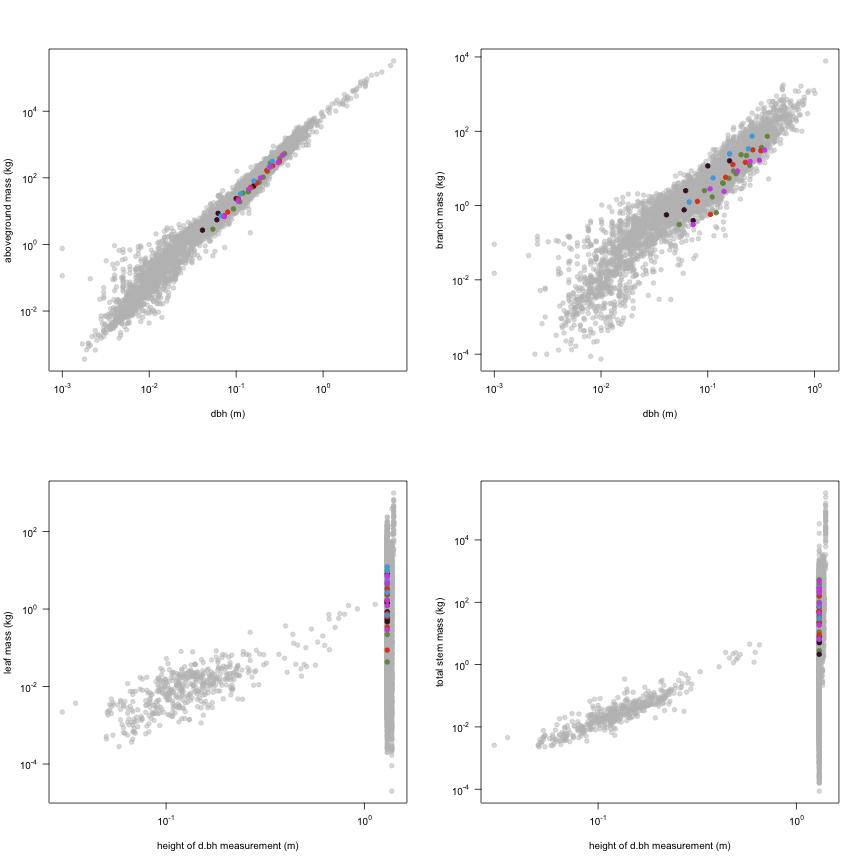-
Notifications
You must be signed in to change notification settings - Fork 19
Kawahara1981
Data contributor: Masae I. Ishihara, Hajime Utsugi, Hiroyuki Tanouchi, Tsutom Hiura
Email: [email protected]
Address:
- Graduate School for International Development and Cooperation, Hiroshima University, 1-5-1 Kagamiyama, Higashi-Hiroshima 739-8529, Japan
- Forestry and Forest Products Research Institute (FFPRI), 1 Matsunosato, Tsukuba, Ibaraki, 305-8687, Japan
- Hokkaido Research Center, Forestry and Forest Products Research Institute (FFPRI), Hitsujigaoka-7, Toyohira, Sapporo, Hokkaido, 062-8516, Japan
- Tomakomai Research Station, Field Science Center for Northern Biosphere, Hokkaido University, Takaoka, Tomakomai 053-0035, Japan
Citation: Kawahara T, Kanazawa Y and Sakurai S (1981). 'Biomass and net production of man-made forests in the Philippines.' Journal of the Japanese Forest Society, 63, pp. 320-327.
DOI:
Abstract:
The dataset includes records for 39 individuals from 5 species belonging to 1 family(ies), presenting 3 functional type(s), growing in 2 condition(s) within 1 major type(s) of habitat, with data included for the following variables:
| Variable | Label | Units | N | Min | Median | Max |
|---|---|---|---|---|---|---|
| latitude | Latitude | deg | 39 | 9 | 9 | 9 |
| longitude | Longitude | deg | 39 | 126 | 126 | 126 |
| a.stbh | Stem area at breast height | m2 | 39 | 0.0013 | 0.02 | 0.1 |
| h.t | Height | m | 39 | 4.3 | 18 | 34 |
| d.bh | Dbh | m | 39 | 0.041 | 0.16 | 0.36 |
| h.bh | Height of d.bh measurement | m | 39 | 1.3 | 1.3 | 1.3 |
| m.lf | Leaf mass | kg | 39 | 0.043 | 1.5 | 12 |
| m.st | Total stem mass | kg | 39 | 2.1 | 51 | 524 |
| m.so | Aboveground mass | kg | 39 | 2.7 | 53 | 533 |
| m.br | Branch mass | kg | 39 | 0.3 | 7.2 | 74 |

And locally within the country:

The sites sampled are:
| Location | Longitude | Latitude | Vegetation |
|---|---|---|---|
| The Philippines-Aras-asan-A2 | 126 | 9 | Tropical rainforest |
| The Philippines-Aras-asan-A4 | 126 | 9 | Tropical rainforest |
| The Philippines-Aras-asan-G3 | 126 | 9 | Tropical rainforest |
| The Philippines-Aras-asan-S | 126 | 9 | Tropical rainforest |
| The Philippines-Aras-asan-D | 126 | 9 | Tropical rainforest |
The growing conditions of sampled plants was:
| Location | growingCondition |
|---|---|
| The Philippines-Aras-asan-A2 | plantation managed, field wild |
| The Philippines-Aras-asan-A4 | plantation managed, field wild |
| The Philippines-Aras-asan-G3 | plantation managed, field wild |
| The Philippines-Aras-asan-S | plantation managed, field wild |
| The Philippines-Aras-asan-D | plantation managed, field wild |
| Species | Family | Pft |
|---|---|---|
| Albizia falcata | missing | deciduous angiosperm, , evergreen angiosperm |
| Unknown | missing | deciduous angiosperm, , evergreen angiosperm |
| Gmelina arborea | missing | deciduous angiosperm, , evergreen angiosperm |
| Swietenia macrophylla | missing | deciduous angiosperm, , evergreen angiosperm |
| Dipterocarp sp. | missing | deciduous angiosperm, , evergreen angiosperm |
Sampling strategy: In February 1980, seven or five trees from each of nine plots were felled (A2 and A4: Albizia falcata plantation, G3: Gmelina arborea plantation, S: Swietenia macrophylla plantation, D: natural Dipterocarp forest). In A4, six sample trees other than Albizia falcata were felled as well. After recording diameters at 0.3 m and 1.3m above the ground, total heights, and the height of the lowest living branch of each sample tree, the fresh weights of the stems, branches, and leaves were determined separately by the stratified-clip technique on one meter of stratum located away from the top and base.
Height: Measured by measuring tape.
Biomass: Small samples of the respective tree components in each stand also were brought to the University of the Philippines at Los Banos for determination of oven-dry weight and leaf area. (Kawahara et al. 1981). Measured fresh weight was converted to dry weight from the ratio of dry to fresh weights.
Other variables: M.I. Ishihara, H. Utsugi, H. Tanouchi, and T. Hiura conducted formal search of reference databases and digitized raw data from Kawahara et al. (1981). Based on this reference, meta data was also created by M.I. Ishihara. Species name and family names were converted by M.I. Ishihara according to the following references: Satake Y, Hara H (1989a) Wild flower of Japan Woody plants I (in Japanese). Heibonsha, Tokyo; Satake Y, Hara H (1989b) Wild flower of Japan Woody plants II (in Japanese). Heibonsha, Tokyo.
This is how the study Kawahara1981 fits in the entire dataset (grey). each colour represents a species. A legend of species names with colours is included at the end for reports with 1 < n < 20 species.







